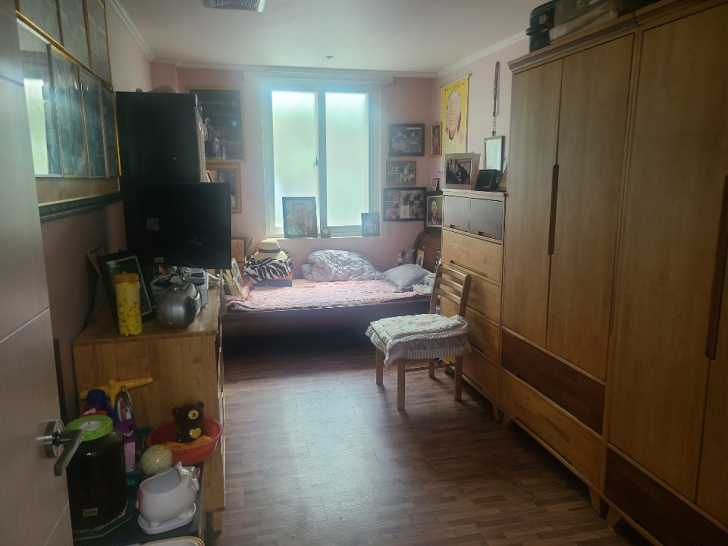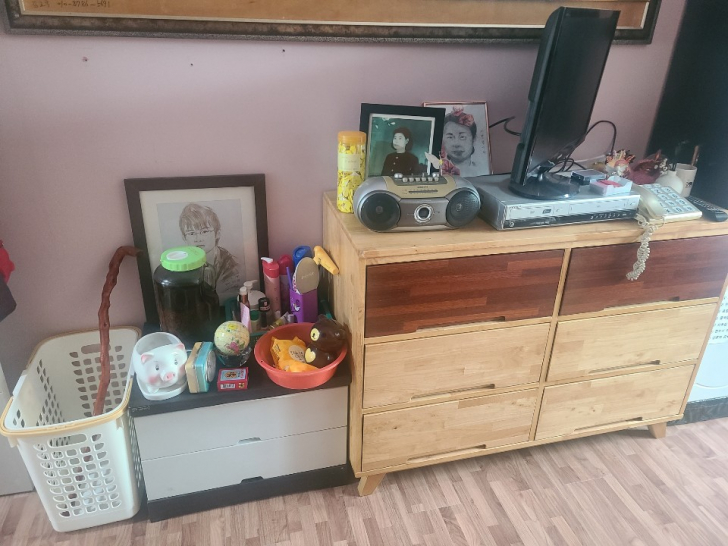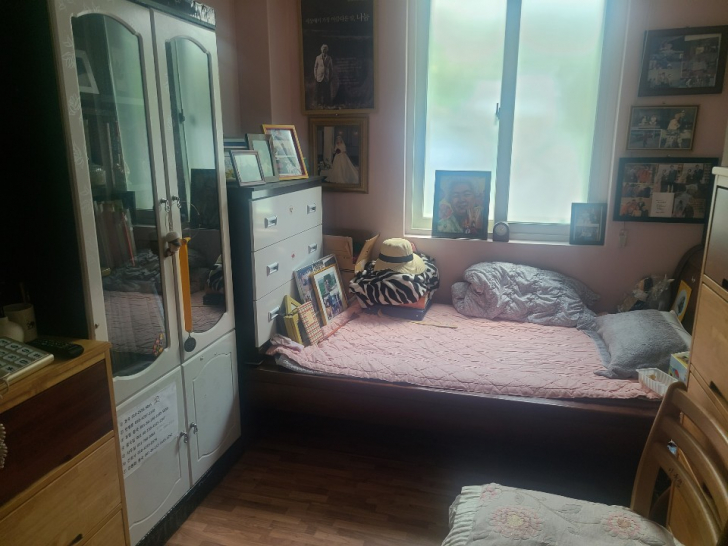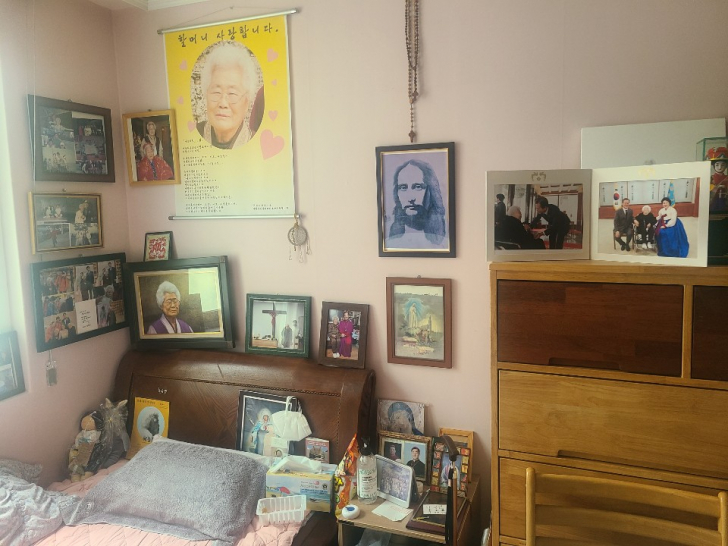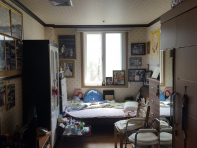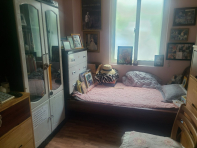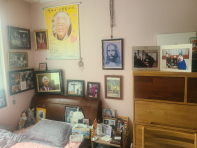The rooms of the surviving “Comfort Women” at the <House of Sharing>
1. The rooms of the surviving “Comfort Women” Part 1 - Lee Ok-sun’s room
2. The rooms of the surviving “Comfort Women” Part 2 - Songnisan Lee Ok-sun’s room
3. The rooms of the surviving “Comfort Women” Part 3 - Park Ok-sun’s room
<The House of Sharing> and the rooms of the surviving “Comfort Women”
In 1991, when our society began to be aware of the Japanese Military “Comfort Women” issue, several organizations began to emerge in order to resolve the “Comfort Women” issue and support the victims. Among them was the <House of Sharing> which opened in Seogyo-dong, Mapo-gu, Seoul in 1992 to provide welfare and a living space for the surviving “Comfort Women” victims. After changing its address to Hyehwa-dong, Jongno-gu, the <House of Sharing> then decided to settle in Gwangju, Gyeonggi-do in 1995. Since then, it has provided a living space for about 30 surviving “Comfort Women” out of the 240 Japanese Military “Comfort Women” victims reported to the government to date, and as of now in August 2020, it remains home to the five surviving “Comfort Women”.
So far, the surviving “Comfort Women” residing in the <House of Sharing> have accused Japan of inhumanity via a plethora of hideous activities and documented their own messages through testimonies, paintings, etc. As a result, the <House of Sharing> is a place filled with copious traces, relics, and memories left by the surviving “Comfort Women”. Thanks to these activities of the surviving “Comfort Women”, the <House of Sharing>, instead of simply being a home for the Japanese Military “Comfort Women” victims, has now become a place that offers various implications for the lives and psychology of the war victims after Japan’s defeat, society’s perception and attitudes towards them, our own roles, and so on.
The traces and history of the surviving “Comfort Women” fill all corners of the <House of Sharing> but are most visible inside the rooms of the surviving “Comfort Women”. The rooms of the surviving “Comfort Women” vividly capture their lives as victims as well as their own personal lives, our perception of the surviving “Comfort Women”, etc. which are embodied in the objects, props, photographs, etc. they own. Although many surviving “Comfort Women” have lived in the <House of Sharing> thus far, the rooms that still remain now are those belonging to the five surviving “Comfort Women”. Except for the room of the late Kim Gun-ja, all of them are occupied by those currently residing in the <House of Sharing>.
However, in the summer of 2019, due to negligence in management by the board and the operating staff of the <House of Sharing>, who did not recognize that the rooms of the surviving “Comfort Women” were an important historical part of the “Comfort Women” issue, all the items of the surviving “Comfort Women” in their rooms were left unattended outside on a rainy day without even basic packaging and were soon soaked in the monsoon rain. As a result, some items were damaged beyond repair and not even a single photograph was saved before the rooms were emptied. It thus seemed difficult for the rooms of the surviving “Comfort Women” to return to their original appearance.
However, after the incident, the fact that the damage had happened against the will of the surviving “Comfort Women” began to stir anger among the staff members of the <House of Sharing>, and this shared indignation resulted in the decision that the rooms of the surviving “Comfort Women” should be restored to their original states. The staff members first moved the items of the surviving “Comfort Women” to a safe space and began searching for the images of the rooms of the surviving “Comfort Women” in newspapers, broadcast programs, social media, etc. including the photographs kept by the <House of Sharing>. Then, the displaced items were organized by each of the surviving “Comfort Women”, and the damaged objects that could be repaired were salvaged first. As a consequence, the rooms of the surviving “Comfort Women” gradually returned to their former appearance. This article focuses on the restored rooms of the surviving “Comfort Women” along with each of the surviving “Comfort Women” who left their traces in those rooms.
Lee Ok-sun's room
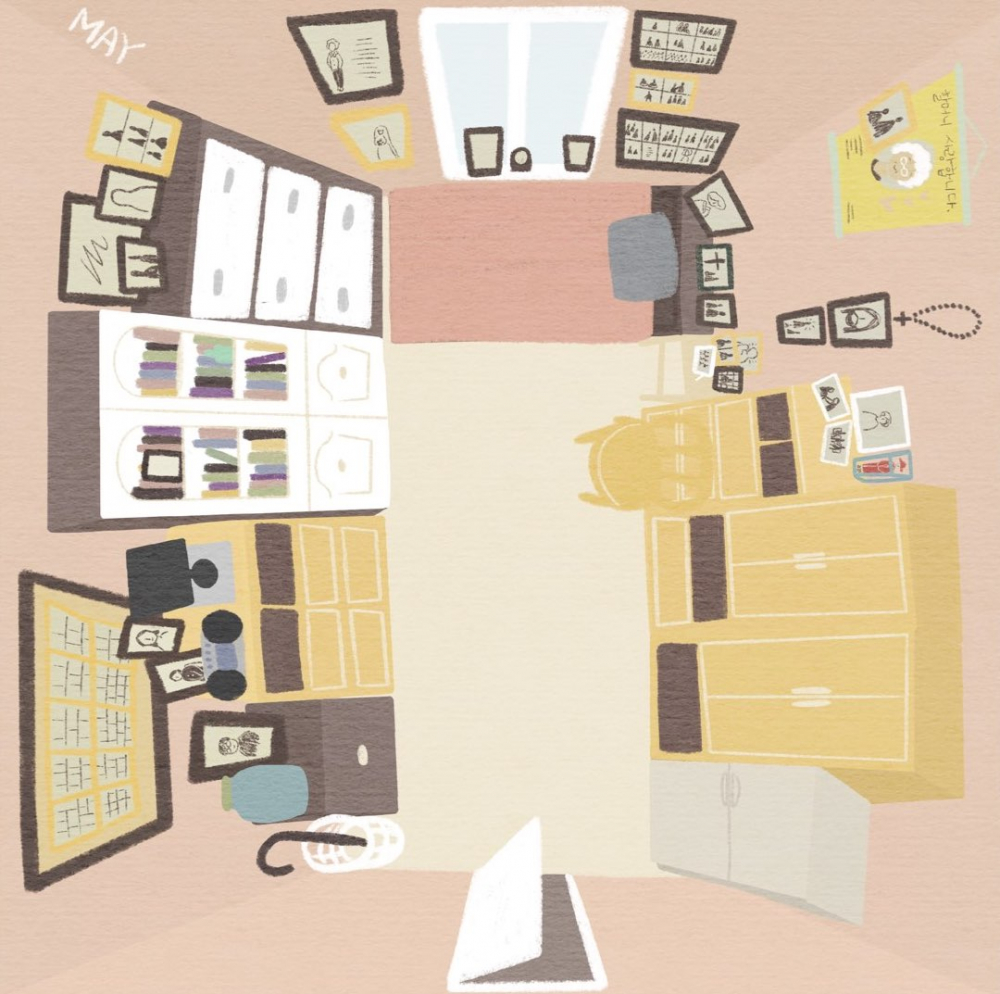
The first room to be restored was Lee Ok-sun's room. After liberation, Lee Ok-sun lived in Yanbian, China, and only came to the <House of Sharing> in 2000 when she returned to the country. However, since she had already been reported dead in South Korea, it took her over a year to reclaim her nationality and register as a victim. Known for her outstanding intelligence and extensive knowledge, she has been attending Wednesday Demonstrations and engaging in testimonies on behalf of the <House of Sharing> to solve the Japanese Military “Comfort Women” issue since the death of the late Kim Soon-deok in 2004.
Lee Ok-sun, who has been living in the <House of Sharing> for over 20 years, is so attached to her room that even when she watches TV in the lounge, she sits at a spot where she can get a good view of her room to check to see who enters her room. Her room, situated at the very front of the <House of Sharing>, is about 4 pyeong in a rectangular structure. At the end of the room, there is a window with a bed below it. A chest of drawers sits on the bed towards the leg of the bed. It is a bit unusual to have a chest of drawers on the bed, but it is possible because the bed is made of stone. And next to that is an old bookshelf displaying mostly Catholic and history books.
Lee Ok-sun's old bookshelf
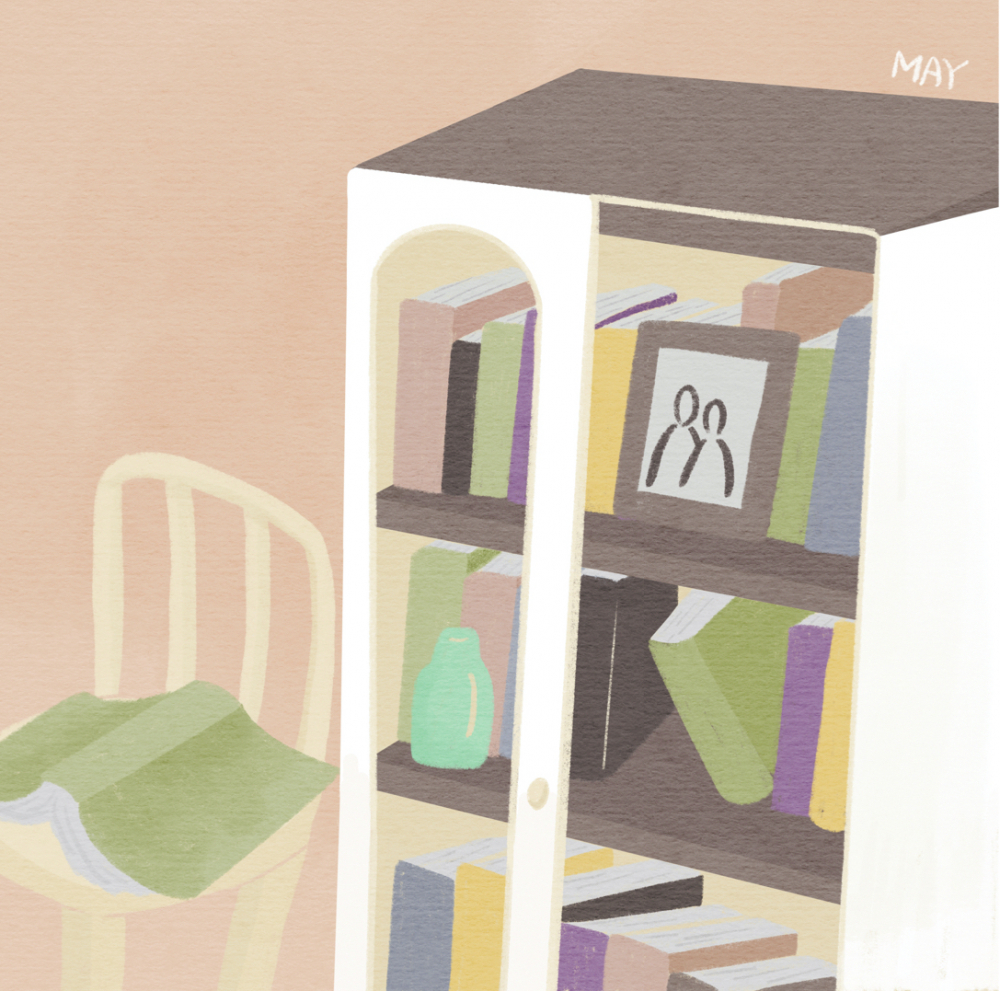
Lee Ok-sun, who is originally from Busan, said that she had been wanting to go to school since she was young. Once she reached 10 years old, she begged her parents to let her go to school, and since her older brother was allowed to attend school, she cried a lot outside the fence of his school because she envied him. In 2019, I visited her hometown in Busan with her. She could not remember much about the past, but she clearly recalled her brother's school, how to get there, and her sorrow about not attending school as a child. Sometimes, when a staff member or visitor looks at the bookshelf in her room and asks, "Grandmother, you have a lot of books", she always unravels her stories about study by replying, "Would you believe it if I told you I have read all those books on the bookshelf?"
Even after liberation, she could not return to South Korea so instead lived in Yanbian, China. One day, a young man in her village told her about an interesting book and suggested she should read it. When she replied to him that she could not read the book because she did not know how to read, the young man introduced her to night school. Lee Ok-sun, who finally learned about the joy of night school, worked on farming during the day and went to night school at night to study the Korean alphabet. Whenever she talks about this, she displays a big grin and says, "I learned how to read the Korean alphabet there!" She also never forgets to boast that after she started going to night school she read rented books every night as she became more and more interested in reading. She was so smart that people in her neighborhood once asked her which university she had graduated from, and she reportedly said, "I graduated from the Department of Agriculture at Homi University". Even these days, whenever I ask her which university she graduated from, she gives me the same answer.
And occasionally, when she talks about the bookshelf and books, she brings up the following story about her being taken to a Japanese Military "Comfort Station". She said that from when she was young, she wanted to learn everything because she had a great desire to study. However, she cried every day because her family was poor and so she could not enroll in school. Then one day, her mother told her that she could go to school if she became an adopted daughter to a family that runs an udon restaurant in front of Busan Station. Thus, she became an adopted daughter to that family, but once she was there, she was only tasked with all kinds of chores and serving alcohols to the customers. Consequently, she ran away from that house several times but on each occasion was caught, and was eventually sold by the owner of the udon restaurant to an inn in Ulsan. While she was living in Ulsan, returning one day from running an errand for the inn’s owner, she was captured by two ‘massive’ men and was taken to a Japanese Military "Comfort Station" in Yanji, China. At first, I did not understand how this story was related to the bookshelf, but at some point I realized that her story was about how she wanted to go to school, not to a Japanese Military "Comfort Station".
Lee Ok-sun's small TV and drawers
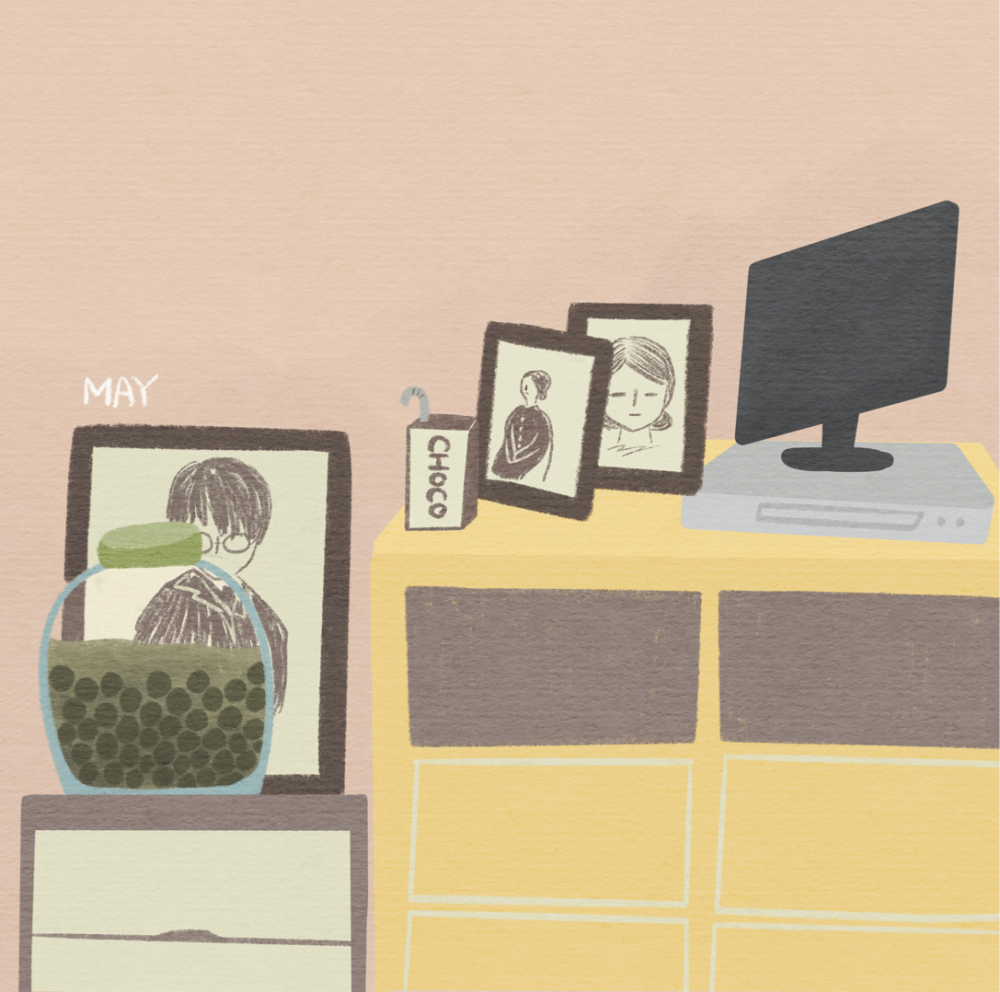
On the right side of the bookshelf, there sits a three-tier cabinet, on which there is a small TV and a photograph of a young Lee Ok-sun. Through this TV, she spends her days enjoying watching <A Long Way Around>, a movie featuring herself as a main character. She asks the first staff member she encounters to play this movie every day and focuses on watching the movie without moving much until it ends. Sometimes I ask her, "Are you not tired of it? Shall we watch something else?", but she replies, "That movie has my history!" and resumes concentrating on the screen. Recently, she also enjoys watching the movie <Let's Play, Dharma> and whenever she lays eyes on the monk character who is great at fighting, she always laughs and says, "That monk is stronger than a gangster". Also, each time the monk’s fight scene appears, she would not start eating even during her mealtime unless she is able to watch that scene.
Next to the bed, the bookshelf, and the cabinet, there is a small two-tiered chest of drawers. On it, there sits a portrait of her grandsons and a bottle of very old plum wine. When a staff member sometimes asks her if they can drink the plum wine, she tells them they can drink it anytime, but nobody drinks it, so the bottle always just sits there without a drop missing. And on the opposite side of the bed, the bookshelf, and the cabinet, there is a five-tier drawer and two closets, with a small refrigerator next to them. The refrigerator is filled with canned chocolate milk and ice cream. The chocolate milk is given to her by Kim Gu-ra, a broadcaster who visits her once a month.
She loves ice chocolate, ice cream, and soda, and it is said that when she first ate ice chocolate, she was amazed to discover something so delicious existed in the world. When she looks a little upset or frustrated, the staff members suggest to her that they should go out to eat ice cream, ice chocolate, or soda. She most likely follows them outside reluctantly. Then, when she is done with the drink she has ordered, she smiles and says, “I am done eating”, or “This makes me feel so refreshed”, or “This is the reason why I came out here”.
Lee Ok-sun's photographs
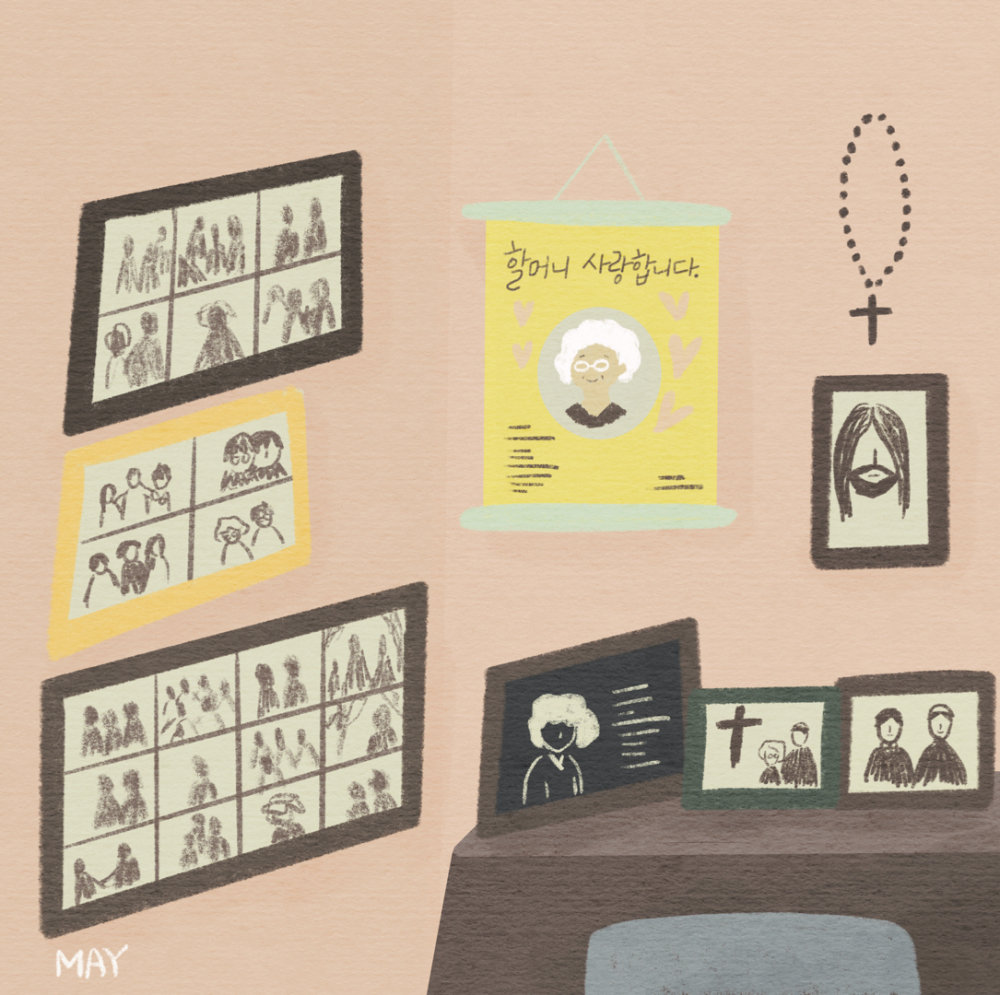
So many photographs and frames hang in Lee Ok-sun’s room that it is hard to see the wallpaper. Since she has been a Japanese Military “Comfort Women” victim for more than 20 years and simultaneously a human rights activist, it is easy to anticipate that she would have countless photographs related to those in her room, but that is not the case. The photographs in her room can be divided into three main categories: first, the photographs related to Catholicism; second, those related to her family; and lastly, those related to her everyday life. There are only a few photographs related to her human rights activities, but they are mostly about the people she got to know through those activities.
She sometimes talks about each photograph hanging in her room, often with a back scratcher to explain those hanging in the spots where her height cannot reach. Among them, all of the photographs that hang closest to her are those related to her Catholic faith. First of all, there are two old rosaries hanging above her bedside, and a small shelf is placed underneath them. On top of the shelf, many photographs related to Catholicism, including the Virgin Mary, St. Andrew Kim Taegon, etc. are densely packed together for a display. Also, the photographs of her and the priest together, portraits of Jesus, etc. hang on the wall above the bed. Lee Ok-sun said that about 30 years ago when she lived in China, she wanted to go to the Catholic church, but she assumed that she was not allowed to do so because she was a victim of the Japanese Military “Comfort Women”. When the nuns heard about it, they gave her a visit to convince her that anyone is welcome in the Catholic church, and from that moment on she started attending the Catholic church. She still goes to the Catholic church every weekend unless something special comes up.
On the opposite side of the pictures related to Catholicism and the Catholic church are the photographs of her grandsons. Lee Ok-sun’s love for her grandsons is so extraordinary that her grandsons’ photographs are placed everywhere in the room where her eyes can reach. When she was young, she became unable to bear children of her own due to the damages caused by being one of the “Comfort Women”. When she was at the Japanese Military Comfort Station, she reportedly received the ‘606 injection’ and mercury therapy which ruined her body. After liberation, she refused to return home but instead met a widower in China who had his own children and set up a family with him. Once, I asked her why she did not think about coming back to her country, and she replied, "How would I be able to look at the faces of my parents and siblings with the sign “Comfort Women” on my forehead?" Anyway, the children of the sons raised by her during that time became her grandsons. However, Lee Ok-sun’s sons and daughters-in-law had disabilities, so she raised her grandsons herself from when they were very young. Now, every one of them is doing their part as a confident member of society, with the exception of her eldest grandson who occasionally gets into trouble.
As such, the history of Lee Ok-sun is engraved in her room. She is so proud of her room that she claims, “I picked every item in my room and purchased each of them myself. My room has everything in it, so I have no need to go to another room to borrow things. Everyone comes to my room to borrow things.” Perhaps that is why she excessively worries that her room might disappear after she is gone. Especially these days, she often says, "Even after I die, please leave my room as it is just like Gun-ja’s room (the late Kim Gun-ja's room)."
Lee Ok-sun's room is just like any other grandmother's room, but it is an extraordinary place at the same time. This room clearly demonstrates what kind of life she has lived and what was important in her life. The room also brilliantly illustrates how our society has chosen to view and remember her. To some, her room may be just a typical room, but the value of this room has not yet been fully appreciated because our society has only seen her as a victim of the Japanese Military “Comfort Women”, not as Lee Ok-sun. Thus, I hope that Lee Ok-sun’s room will remain intact and be preserved as a precious record that offers various perspectives on the individual victims as well as the Japanese Military “Comfort Women” issue.
Credit
Illustrated by Baik Jung-mi
Related contents
-
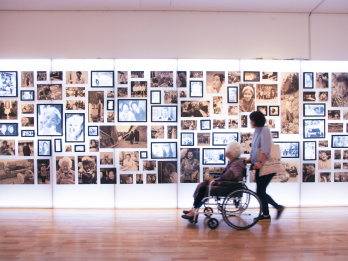
- The End of the Tunnel - Interview with Kim Dae-wol, the Head Curator of the House of Sharing
-
Kim Dae-wol, Head Curator of the House of Sharing
-

- The rooms of the surviving “Comfort Women” – Songnisan Lee Ok-sun's room
-
Songnisan Grandmother had anticipated that she would live in Songnisan for the rest of her life but ended up coming to the <House of Sharing> in the fall of 2018 after having knee surgery which made it difficult for her to easily move around.
-

- The rooms of the surviving “Comfort Women” - Park Ok-sun’s room
-
Upon Park Ok-sun's return to South Korea, she moved back and forth between her younger brother's house and her nephew's house in Seoul, and eventually was admitted to <House of Sharing> in 2002.
- Writer Kim Dae-wol
-
He is the Head Curator of the <House of Sharing>. He completed a doctoral course in the Department of Korean History at Kookmin University. He was in charge of the overall planning of <The End of the Tunnel>. While working and studying simultaneously, he gives special lectures on the Japanese Military “Comfort Women” issue by taking advantage of his experience whenever possible.
corea807@hanmail.net

